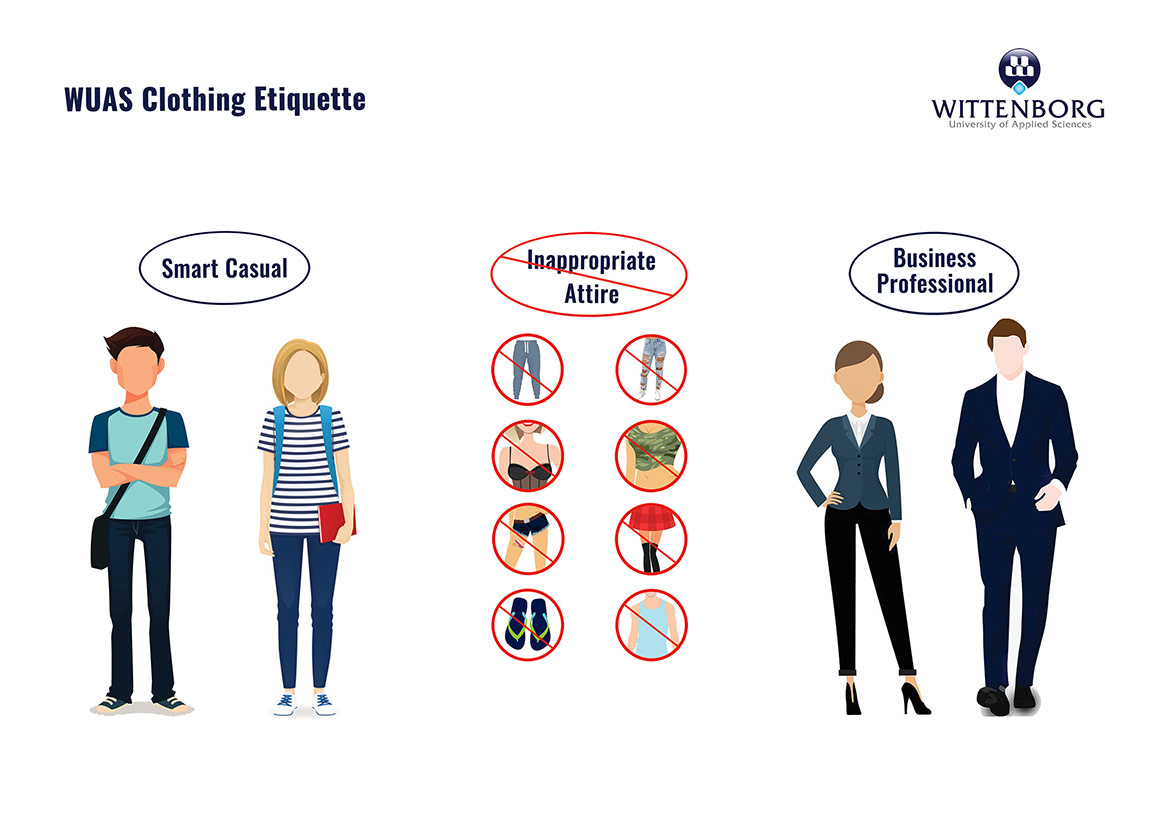Wittenborg Online News!
An Overview of Wittenborg’s Clothing Etiquette
An Overview of Wittenborg’s Clothing Etiquette
In order to provide students with guidelines and tips on how to dress for specific occasions and activities, as well as help prepare them for the social expectations related to their future careers, Wittenborg has adopted a clothing etiquette with effect from the new academic year 2022-2023. With this, the school intends to help students develop good work ethics, given that clothing is also a means of communication. The detailed information can be found in Wittenborg’s Education & Examination Guide (EEG) – Part 4: Practical Information Guide.
School’s Guidelines Provide Information on What to Wear in Casual and Formal Contexts
In order to provide students with guidelines and tips on how to dress for specific occasions and activities, as well as help prepare them for the social expectations related to their future careers, Wittenborg has adopted a clothing etiquette with effect from the new academic year 2022-2023. The detailed information can be found on pages 12 and 13 of the school’s Education & Examination Guide (EEG) – Part 4: Practical Information Guide.

Because ethics is one of Wittenborg’s main pillars, the school intends to help students develop good work ethics, and appearance plays a role in this, since clothing is also a means of communication. Moreover, appropriate self-presentation is just as important in the physical world as in social media for successful employability. Therefore, students are expected to use good judgement in their selection of attire, grooming, appearance, personal hygiene and personal habits, choosing the proper outfits for each specific context.
According to Wittenborg associate professor Dadi Chen, the way we
dress is a type of language, and our choice of clothing is a way to tell
people who we are and what our relationship with them is. “Being
skilled at a language does not mean knowing as many different styles and
expressions as possible, but more importantly, it means knowing what
appropriate style to use on a specific occasion. For the same reason,
being able to choose an appropriate dressing style for a specific
occasion is a necessary professional competence to a business person. As
part of our professional education, students at Wittenborg need to know
how to express and identify themselves on business occasions. Smart
casual is the generally accepted dressing code in most business and
educational activities; it is a manner of expressing your professional
identity and respect to other professionals, and should be encouraged
among students,” he highlighted.
It must be stressed that Wittenborg is proud of the cultural and
international diversity of its students and staff. In view of this,
students and staff are allowed and invited to express their own cultural
and religious identification, as long as they are in line with the
descriptions of smart casual and business professional attire
respectively. Students attending classes should be dressed in Smart
Casual attire and, for formal presentations, oral defences, graduation
ceremonies or while representing the school at an event, they should be
dressed in Business Professional attire.
What is Smart Casual Attire?
Smart casual attire is an everyday, neat, casual look, combining comfort and elegance. There are many possibilities of combinations, including items such as collared button-up shirt, sweater, pants, slacks, skirts and dresses of decent length, blazers, jackets, boots, loafers etc. Religious head covering, winter caps, and beanies may be worn as long as they do not cover the face.
What is Business Professional Attire?
Business professional attire is another step closer to elegance and one step away from casual when compared to smart casual. The way students present themselves can play a big role in their professional careers; therefore, Wittenborg requires this attire to be worn when more formal events take place, such as presentations, oral defences, graduation ceremonies or similar occasions.
Inappropriate Attire
Students should keep in mind that not all kinds of attire are appropriate for an educational or business environment. For this reason, students are expected to adhere to the appropriate clothing etiquette as set out by Wittenborg as a way to express a positive and professional attitude. Examples of attire which Wittenborg considers inappropriate are clothing with prints that depict profanity or which contains inappropriate pictures or insignias, clothes which are too revealing, shorts or beach attire. More details of the appropriate and inappropriate attire can be found in the EEG.
WUP 4/9/2022
by Ulisses Sawczuk
©WUAS Press
740 words